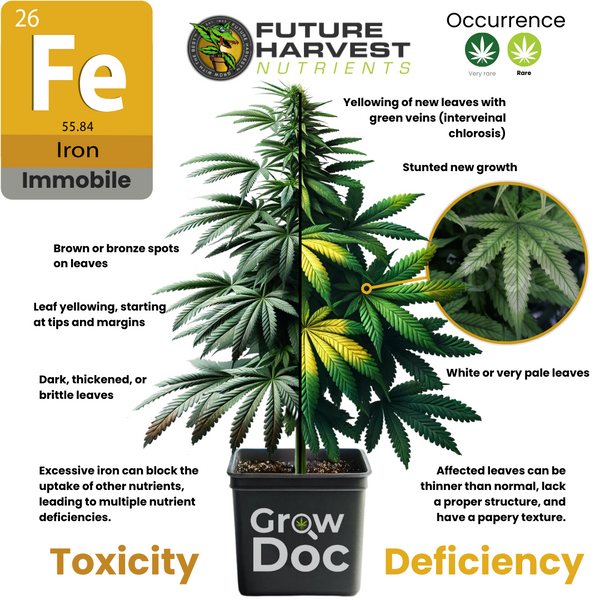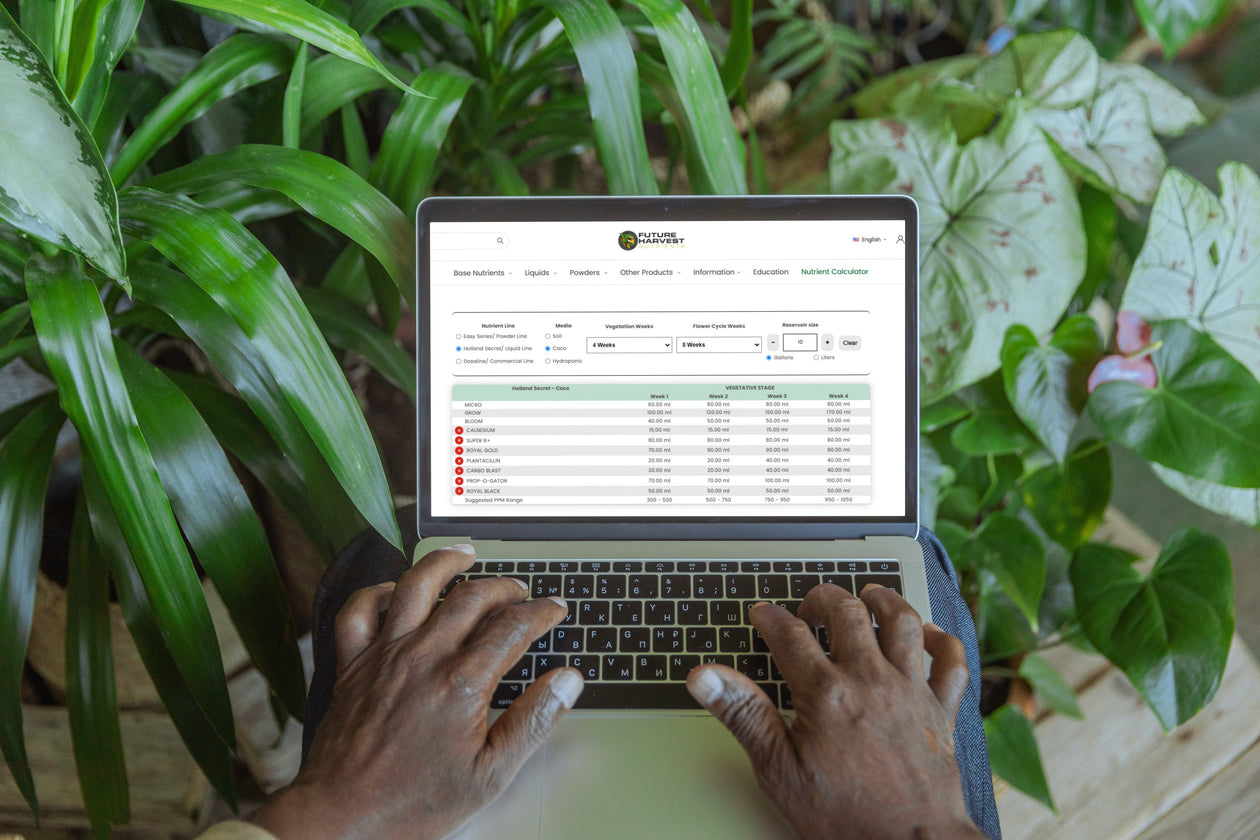How to Find and Fix Iron Deficiency in Cannabis Plants

Iron Deficiency and Toxicity in Cannabis Cultivation
For cannabis connoisseurs and growers alike, the pursuit of the perfect plant is akin to an art form, with each nutrient playing a pivotal role in crafting the final masterpiece. Iron, though less celebrated than its macro cousins, is the unsung hero in your plant’s growth narrative, influencing everything from the vibrancy of leaves to the potency of buds.
In this chapter of our Nutrient Management series, we're not just dusting off old charts; we're diving deep into the essence of iron in cannabis cultivation. Whether you're a first-time grower or a seasoned cultivator, understanding iron's critical role can mean the difference between a just-okay harvest and one that's downright legendary.
Did You Know?
Although iron is considered a micronutrient and only required in small amounts, it is a critical component for a number of plant processes. Iron is required for the production of chlorophyll, the primary pigment used in photosynthesis where light energy is absorbed and stored to produce food for the plant.
Discover More Iron FactsThe Role of Iron in Cannabis Plants
Iron is a powerhouse in the world of cannabis cultivation, playing a crucial role beyond just chlorophyll synthesis. It's vital for the electron transport chain within plant cells, essential in energy production, and crucial for creating ATP — the energy all cells live on.
Beyond energy, iron is used in developing defensive enzymes against pathogens and forming aromatic oils and resins, enhancing both the plant's fragrance and its defense system. It bolsters root health, enabling more efficient water and nutrient uptake, and contributes to the lush, dark green color of healthy leaves.
While iron is indispensable for both vegetative growth and flowering, managing its levels is key. Iron interacts with other nutrients and is affected by the medium's pH, requiring careful balance to avoid deficiencies or toxicities.
Iron and pH: Managing Absorption in Cannabis Plants
Iron's availability is a balancing act, heavily influenced by pH levels. Drift too far from the sweet spot, and iron becomes elusive, causing deficiency; stray in the opposite direction, and it overwhelms, leading to toxicity. A measured approach to pH can lead your plants to a state of iron-infused nirvana.
Expert Insight
Getting iron levels just right in your cannabis grow comes down to mastering the pH game. If your grow medium's pH strays too high or too low, iron starts playing hard to get. Too alkaline, and iron locks up, leading to deficiency. Too acidic, and you might just tip into toxicity territory. The trick? Keeping your pH dialed in tight. Nail that, and you're setting the stage for your plants to soak up iron in just the right amounts, setting them up for lush growth and stellar buds.
Common Causes for Iron Imbalances in Cannabis Cultivation
Iron imbalances can throw a wrench in your grow operation, but pinpointing the cause is the first step toward getting back on track. Here are the usual suspects behind iron woes in your cannabis garden:
-
pH Imbalance: The most common culprit. Iron thrives in a specific pH range. Outside of this, it either becomes unavailable or too abundant. Keep that soil or hydro solution between 6.0 to 6.5 for soil grows, and slightly lower for hydroponics, to stay in the iron sweet spot.
-
High Calcium Levels: An excess of calcium can block iron uptake, leading to deficiency symptoms even when there's plenty of iron around. It’s a balancing act between these two essential nutrients.
-
Poor Drainage and Overwatering: Soggy conditions are a no-go for healthy iron uptake. Overwatering can lead to root issues, reducing the plant's ability to absorb iron and other crucial nutrients.
-
Excessive Use of Phosphates: High phosphate levels can also interfere with iron absorption, showcasing how nutrient balance is key to avoiding deficiencies.
-
Cold Soil Temperatures: Iron absorption slows down in cold conditions. Keeping root zones at optimal temperatures ensures your plants can take up iron efficiently.
-
Competing Micronutrients: Like characters in a drama, micronutrients can outcompete each other for the spotlight. Too much zinc, manganese, or copper can limit iron availability, leading to deficiency.
How to Find: Identifying Iron Deficiency and Toxicity
Identifying iron issues early can save your cannabis plants from a world of trouble. Here's how to spot the signs:
Iron Deficiency Symptoms in Cannabis Plants
- Young Leaf Yellowing: The newest, uppermost leaves turn a pale yellow or white, especially between the veins, while the veins themselves may stay green.
- Stunted Growth: Plants look underdeveloped, with smaller leaves and reduced overall size.
- Poor Flower Development: Buds might not form correctly or might be smaller than expected.
Iron Toxicity Symptoms in Cannabis Plants
- Dark Spots on Leaves: Excess iron can cause dark, bronze, or brownish spots on leaves, a sign that nutrients aren't being processed correctly.
- Leaf Drop: An overload of iron might cause leaves to fall off prematurely.
- Root Damage: Roots can become discolored or damaged, affecting the plant's ability to uptake water and nutrients.

How to Fix: Iron Deficiencies and Toxicities in Cannabis Plants
For Deficiency: To tackle iron deficiency, consider using a chelated iron supplement that's readily available to your plants. This can provide a quick boost to affected plants. For a more gradual improvement, amending your soil with organic matter that naturally contains iron (such as certain composts) can help. Carefully watch your plants for signs of recovery, adjusting your approach as necessary to ensure you're not adding too much.
For Toxicity: Addressing iron toxicity starts by immediately stopping any iron supplements. Flush your growing medium with clean, pH-balanced water to wash away excess iron. After flushing, reintroduce your regular nutrient regimen minus the additional iron. Keep a close eye on your plants' recovery, making sure the problem doesn't repeat. Adjust your nutrient mix to maintain a balanced delivery of essential elements, ensuring iron levels are kept in check.
Maintaining Optimal Iron Levels
Maintaining the right balance of iron is crucial for the health and productivity of your cannabis plants. Regular testing of your soil or growing medium's pH and nutrient levels is essential. Aim to keep pH levels within the ideal range for cannabis (6.0 to 6.5 for soil, 5.5 to 6.5 for hydroponics) to facilitate optimal iron uptake. Incorporate a balanced nutrient regimen that includes all essential micronutrients, with a special focus on iron during the plant's vegetative and early flowering stages. Adjustments should be made based on the specific phase of growth and visible signs of the plant's condition.
Enhancing Iron Uptake in Soil-Grown Cannabis
For soil growers, enhancing iron uptake means ensuring your cultivation practices and environment are dialed in. Here are some strategies:
- Amend Soil: Use iron-rich amendments like greensand or use chelated iron products that are more readily absorbed by cannabis roots.
- Optimize Root Health: Promote a robust root system with adequate aeration and avoid overwatering to facilitate better nutrient uptake, including iron.
- Microbial Inoculants: Beneficial microbes can enhance nutrient availability, including iron, by improving soil structure and facilitating nutrient exchange.

Optimize Your Feeding Schedule with Future Harvest
Conclusion and Next Steps
By recognizing the signs of deficiency and toxicity, adjusting cultivation practices, and maintaining a vigilant eye on pH and nutrient balances, growers can ensure their plants have access to the iron they need throughout their lifecycle.
As we continue to explore the intricacies of cannabis nutrient management, remember that each element, including iron, plays a unique role in the health and productivity of your plants. Stay curious, keep testing, and adjust your practices based on what you learn. The path to a bountiful harvest is paved with knowledge, attention, and care.
Explore Nutrient Deficiencies and Toxicities
| Nitrogen | Phosphorus | Potassium |
| Calcium | Magnesium | Sulfur |
| Boron | Iron | Manganese |
| Symptomology Guide | ||
